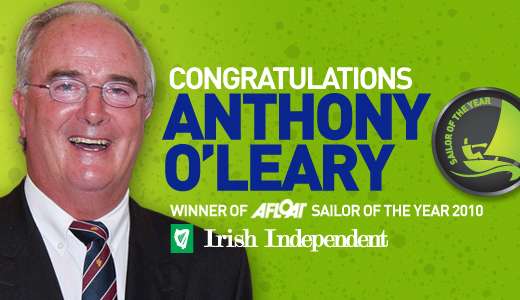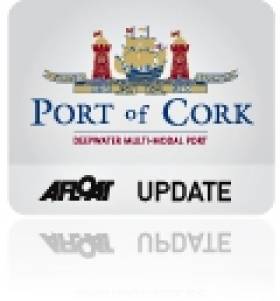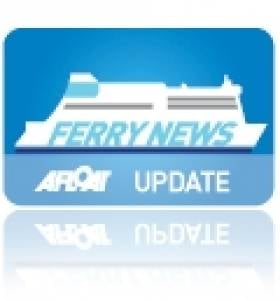Displaying items by tag: Cork Harbour
Afloat's March/April Issue Out Next Week!
Is there no end to the achievements of Irish boaters against seemingly impossible odds?
The winter may have been a time of hibernation for some of us but as the stories in Afloat's March/April issue will bear out Irish sailors have been battling the elements all winter long.
James Carroll competed in January's Sydney-Hobart offshore race and, much closer to home, Paul A. Kay journeyed through snow and ice in December from Dun Laoghaire to a new marina on Valentia Island.
As if to prove a point that we're down but not out, a winter of results on foreign waters includes a win in the Mirror World Championships in Australia and a top Olympic result in Florida, USA.
They are gutsy performances from youth teams that shows, if nothing else, the next generation of Irish sailors is really up for a fight. All this plus lots, lots more on news-stands next week!
Selected contents from Ireland's only boating magazine include:
News
Surveyors Issue Boat Launch Warning, Buoyant Dinghies Buck the Market, Ice Diving in Ireland, German U-Boat Rediscovered in Cork Harbour, an Historic Trophy for South Pacific Dream Cruise, MGM open in Cork, Hugh Mockler joins Crosshaven Boatyard plus lots, lots more.
News Focus
A new masterplan for Dun Laoghaire harbour is badly needed but it needs buy in from all those that use it
Going Offshore
The tenth Dun Laoghaire to Dingle offshore race was launched in style
Marine Conference
Combating the downturn was the focus of a unique marine gathering on both sides of the Irish sea.

Gear Review
New dinghy gear, a new Crosshaven boot from Dubarry, a new raincoat for girls and an upgrade for Musto's MPX.

This Island Nation
The decision to shut down the fog signals was based on a detailed risk assessment. Tom MacSweeney on the loss of fog horns
Sailor of the Year
Anthony O'Leary of Cork is the Afloat.ie/Irish Independent "Sailor of the Year" in celebration of his outstanding achievements afloat nationally and internationally.
Tall Ships
W M Nixon looks at the realities of national sail training in the 21st Century.
Tall Ship Conference
Ireland could yet have a tall ship to replace the Asgard II and the Lord Rank, if a new group formed to press for a replacement is successful
Racing update
Ulstermen's World Title, Topper worlds for Dun Laoghaire, Two Irish campaigns line up for Figaro Race, SB3 Sailors Cry Foul at Dun Laoghaire Parking Fees and an Irish entry in the Moth worlds in Australia, Irish Mini 6.50 Campaign in Prospect.

Youth Worlds preview
Results achieved abroad this Winter are the backbone for further Irish youth
success

Figaro Preview
Two fledgling Irish La Solitaire du Figaro campaigns edged closer to the start line last month
Volvo Dun Laoghaire Regatta
Volvo Dun Laoghaire regatta has taken in 22 entries six months ahead of the first race of the biggest regatta in Irish sailing.

Fireball Worlds preview
Dun Laoghaire's Noel Butler intends to continue his winning run in the Fireball class this season but the year ahead doesn't look so easy as the World Championships come to Sligo
Sovereigns cup preview
Up to 30 Quarter tonners will be at the Sovereigns Cup this year including one from New Zealand.
Shiver to deliver
A journey through snow and ice from Dun Laoghaire to Valentia Island
Sydney-Hobart Race
Outside of the Volvo Ocean Race, the Sydney Hobart is one of the world's most challenging offshore races. James Carroll Raced it in January.
Inland
As the cuts begin to bite, it may be time to look at the British direction for our waterways, writes Brian J Goggin
Dubarry Nautical Crossword
Soundings
A Google aerial photo proves useful navigating for Baldoyle Estuary
- Anthony O'Leary
- Dun Laoghaire
- Tom MacSweeney
- Harbour
- MGM Boats
- Asgard II
- World Championships
- Dinghies
- Olympic
- Cork Harbour
- Valentia
- Mirror
- Dingle
- youth
- Lord Rank
- Island Nation
- Hugh Mockler
- Dubarry
- Tall ship
- brokerage
- sydneyhobart
- fog horn
- moth
- Mini 6.50
- Uboat
- Fireball worlds
- Sovereigns
- James Carroll
- Paul A. Kay
- Crosshaven Boatyard
- Baldoyle
- MPX
- W M Nixon
Preparing for the Challenge of La Solitaire du Figaro
Dubliner Paul O'Riain's comprehensive article on his Figaro debut experience in 2007 has moved, Click this link for it and the latest La Solitaire du Figaro news.
Former WW II Oil-Tanker Lays Cables Across Cork Harbour
To read further information about the cable installation project which is listed on the Port of Cork Company website under Notice to Mariners (No. 6 of 2011) click here.
The odd appearance of the barge masks a colourful and chequered career, as only a remnant of the original vessel survives (see photo). Only the forward section and bow (90m long X 20m beam) remain after the partial scrapping of the former oil tanker, Esso København, which took place nearly fifty years ago.
She was launched in 1930 as the MS Peter Hurll by the Palmers Shipbuilding and Iron Company Ltd (Yard/Hull no. 479) at Hebburn-on-Tyne, England. Measuring 11,952grt the tanker was commissioned for Baltisch-Amerik Petroleum Import G.m.b.H. (Waried Tankschiff Rhed.) of Danzig. For further details click here.
The vessel's profile was typical of the era, with a 'two-island' arrangement where the bridge superstructure is sited amidships and separated from the crew's accommodation quarters located aft on the poop deck at the stern.
At 452-foot long, the 17,585dwt vessel had a cargo carrying capacity of 138,108 barrels, which had an assigned pumping rate of 4,000 barrels an hour. The twin-screw diesel powered vessel had 5,300 brake horsepower engines that gave a speed of 12.3 knots.
In 1935 the vessel was sold to the Panama Transport Co. of Panama. While en route to Aruba, with an American crew, war was declared in Europe on September 3, 1939. At the Caribbean island's port of Las Piedras the Peter Hurll loaded her first war-time cargo of 106,514 barrels of fuel and crude oils bound for Everett, Mass.
Throughout the war years the Peter Hurll was crewed at various times between Americans and Danes. To read in greater detail the career history of the vessel and an account of the attempted U-Boat attack on the Peter Hurll click here. The tanker had several sisters, the F. H. Bedford Jr, J. H. Senior, J.A. Mowinckel and The Heinrich v. Riedemann which was lost on April 16, 1942.
Only a few months after the war in February 1946, the Peter Hurll bunkered the Queen Mary, which was moored alongside Pier 90 on the North River, New York. In less than 10 hours the vessel tranferred 27,797 barrels of fuel in a direct tanker-to-ship delivery of fuel oil. The famous 80,000 tonnes Cunard liner which like the tanker, was also built in 1930, had been recently re-converted from a troopship to her peacetime role as a passenger-liner.
In 1967 the liner retired and the vessel is moored at Long Beach, California, as a static hotel, restaurant and museum (see www.queenmary.com).
Two years later the Peter Hurll changed ownership to Det Danske Petroleums A/S of Copenhagen but later under the control of Dansk Esso A/S was renamed Esso København (see link) and the vessel was enlarged to a tonnage of 12,043grt.
In 1952, the vessel was taken to Odense, Denmark by H. J. Hansen, where the vessel was partially broken-up. The remaining fore-end survived and was rebuilt as a cable / pipe laying barge in 1963 (click here). The structure which essentially is a barge was named Henry P Lading for new owners, Nordisk Kabel og Traadfabrikker A/S, Copenhagen.
At one stage the barge was renamed "Nkt Cables a/S" but in 2002 the barge was sold to Jydsk Dykkerfirma ApS, now named JD Contractor A/S. The company (click here) is the largest underwater contractor in Denmark, providing diving assignments and the laying and embedding of submarine cables and pipelines worldwide.
Only late last year, scuba-divers found a fully intact World War I U-Boat on the seabed just outside Cork harbour. To read more about the U-Boat which sank some 93 years ago and photos click here.
Hugh Mockler Joins Crosshaven Boatyard
Crosshaven Boatyard Company Ltd has announced that Hugh Mockler, (formerly of HM Yachts Ltd), is to join long established yacht broker, Donal McClement in the Boatyard's new boat and brokerage sales division.
Matt Foley, General Manager of Crosshaven Boatyard, told Afloat, 'Donal and Hugh are two of the best known and most successful Yacht Brokers in Ireland. Over the past number of years and their combined knowledge of a very difficult market will ensure that the buyers and sellers get a top class service'. Hugh and Donal will be able to give buyers and sellers the best possible advice.'
Crosshaven Boatyard has been providing marine services for over 60 years.
The boatyard also specialises in all aspects of the repair and maintenance of modern pleasure boats. Many well-known boats such as Gypsy Moth V, the Saint Brendan, Longbow II and a series of Moondusters were completed in the1980s.
It was the first commercial marina, with a marine travel hoist, in Ireland in 1979. The yard is the Irish distributor for Dufour Yachts of France, and Grand Soleil, of Italy.

Hugh Mockler (left) is greeted by General Manager Matt Foley (centre) and yacht broker Donal McClement. Photo: Bob Bateman
Amendments to Pilotage Byelaws
For further information about this and to download a copy of the Pilotage Byelaws click this link. In addition the port company has a draft copy of the Pilotage Byelaws which is available for collection from:
The Port of Cork Company, Custom House, Custom House Street, Cork
The port can be contacted by Tel: 021 4273125 and for other genaral information on the port logon to www.portofcork.ie
Outstanding Anthony O'Leary is Worthy Sailor of the Year
Anthony O'Leary of Cork is the Afloat.ie/Irish Independent "Sailor of the Year" in celebration of his outstanding achievements afloat nationally and internationally throughout last season, and to honour his dedication to sailing in all its forms both as a participant and an administrator.

The O'Leary pace afloat and ashore belies his age of 53. During 2010, it was in May that he was "Sailor of the Month" for an already remarkable list of wins with his Ker 39 Antix. Having topped the April Series in Kinsale, he then won the Crosshaven-Dun Laoghaire race overall, went on to win his class and be one of the top points scorers in the ICRA Nationals in Dublin Bay, and then went on to Scotland to win his class overall with a nail biting brace of wins on the final day of the Scottish Series.
To achieve all that before May was out was exceptional, but the O'Leary progress was only beginning. The big picture was to maintain momentum towards the international Commodore's Cup in the Solent in August. Antix was one of the three boat squad, and her skipper was also the team captain in a campaign which was light years away from the glossy efforts which dominated the boom years of Irish affluence.

Anthony O'Leary takes on the waves at the helm of his yacht Antix during Cork week in Cork Harbour. Photo: Bob Bateman
In previous seasons, Ireland had been able to muster enough boats for two or even three teams, yet had never won despite being within inches of success. But this time round, only three boats were game for it, and only one – Rob Davis's Corby 36 Roxy – was new. Yet with Dave Dwyer's ever-keen Mills 39 marinerscove.ie filling the third slot, O'Leary headed a potent force, and he himself sailed with style and inspiring sportsmanship to give Ireland a commanding overall win.
Anthony O'Leary is the personification of Irish sailing at its very best. With the enthusiastic support of his wife Sally, he is father to a family which has logged outstanding sailing success at all levels. Yet he himself is in many ways the quintessential club sailor. He is as happy racing the Autumn series at Crosshaven with a 1720 or the West Cork regattas with a cruiser-racer, as he is competing at the highest levels. He has been among the front runners for the title of Ireland's "Sailor of the Year" several times. And now, as with all his wins, when he does do it, O'Leary does it with style.
Crosshaven Lifeboat Recover Body in Ringabella Bay
Crosshaven RNLI Lifeboat report that they have recovered the body of a missing fisherman from the sea at Ringabella Bay after information received from a person on shore. The fisherman was lost when the fishing boat sank almost four weeks ago.
Related Safety posts
RNLI Lifeboats in Ireland
Safety News
Rescue News from RNLI Lifeboats in Ireland
Coast Guard News from Ireland
Water Safety News from Ireland
Marine Casualty Investigation Board News
Marine Warnings
‘Proposed’ Cork-Spain Route Remains Under Review
In addition to services running out of Rosslare operated by Celtic Link Ferries and Irish Ferries and the alternative option of landbridge connections to Europe via the UK.
In the meantime, the Port of Cork will continue to be in dialogue with potential operators and investor's, however in the current climate it is proving more challenging to establish the service. Yet both the port authorities in Cork and Gijon remain committed in establishing the first direct Irish-Iberia passenger ferry route, with an update on the Spanish service due in early June.
Since 2008 the port authorities of Cork and Gijón, through the Promotion of Short Sea Shipping and Co-Operation with Small Medium Enterprise's (Proppose) an EU Inter-Reg project, have conducted feasibility studies into the service.
Interest in the service to date, has shown interest from Brittany Ferries, P&O Ferries and Transfennica, a Scandinavian based operator. It was envisaged that a ro-pax type of vessel would operate the 24-hour route to Gijón in Asturias, the region which forms part of Spain's northern 'Green' coast.
The route across the Bay of Biscay would be an attraction to freight hauliers, saving mileage and reduced fuel costs in addition avoiding a weekend ban to trucks travelling through France.
Last summer the ro-pax Norman Bridge started a new route between Nantes / St. Nazaire (Montoir-de-Bretagne) and Gijón, operated by GLD Atlantique. This route received support through the EU 'Motorways of the Seas' (MOS) programme to divert vehicle traffic from congested road-infrastructure and transferred to designated shipping routes, using larger and faster ro-pax vessels.
The route's opening was marked with a declaration signed by Dominique Bussereau, the French Minister of State responsible for Transport and his Spanish counterpart Magdalena Alvarez of the first of two Franco-Spanish MOS concept routes, starting with the 14-hour GLD Atlantique service.
- Irish Ferries
- port of Cork
- Celtic Link Ferries
- Fastnet Line
- P&O Ferries
- Brittany Ferries
- Ports and Shipping News
- Cork Harbour News
- RoPax
- Port of Gijón
- Proppose
- Motorways of the Seas
- MOS
- Transfennica
- CorkGijón
- Asturias
- 'Green'Spain
- Landbridge
- NantesSt.Nazaire
- GLD Atlantique
- Norman Bridge
- Cork Harbour
Rejig Means No South Coast Match Racing Fixtures
There will be no match racing on the south coast this year following a rejig of the fixtures calendar.
After two years of expansion for match racing in terms of events the theme for 2011 is consolidation.
Changes to the ISA SailFleet schedule for the boats mean that we have had to go through a rejigging of the match racing calendar.
The major impact is that Royal Cork YC are to take the boats latter than originally hoped meaning that they will be unable to host a leg of the Tour.
With Kinsale not taking part in the SailFleet scheme this year that means no match racing on the south coast for the first time in a couple of years.
With no tie up with the Dun Laoghaire Festival of Cultures available this year a date of July 23rd and 24th has been settled on for the Ireland vs The World International.
The highlight of last year this event will once again pit Irelands 6 best match racers against 6 teams from the rest of the world. Once again National and Tour champion John Sheehy will captain the Irish team.
The Leinster Match Racing Open, to be hosted by the Royal Irish Yacht Club, has been moved to July 16th and 17th to allow it to act as qualification for the Irish team for the following weekend and to give Laura Dillion and the Gladiators (Sam Hunt, Paddy Blackley, Peter Bayly, Richard Murphy) competitive practice immediately before heading over to Poland to represent the country at the ISAF Nations Cup.
Howth Yacht Club's, Dublin Match Racing Open stays with a date of September 3rd and 4th before we head for Lough Derg and the Womens (October 15th and 16th) and Open National Championships (November 5th And 6th).
All of the above means that here will be no Munster Match Racing Open this year and work continues to find a host for the IUSA Student Match Racing Nationals with Galway a potential for early April. There has been considerable work on the cost of entry for events over the winter and the majority of events will have a basic entry of €330 this year. All events will be run at ISAF grade 3.
Revised calendar
July 16-17th – Leinster Match Racing Open, Royal Irish Yacht Club
July 23-24th – Ireland vs The World International, Royal St George Yacht Club
September 3rd and 4th – Dublin Match Racing Open, Howth Yacht Club
October 15th and 16th - Womens Match Racing Championships, Lough Derg Yacht Club
November 5th and 6th – National Match Racing Championships, Lough Derg Yacht Club
Royal Cork Seek Operations Manager
The Royal Cork Yacht Club is recruiting an Operations Manager on a fixed term contract basis.
The Club offers a full range of sailing facilities, comprising a 200 berth marina, 40 moorings, extensive dinghy facilities, seven-day hospitality service and a full 12-month schedule of sailing activities.
Operating from Crosshaven, Co. Cork, the Royal Cork Yacht Club celebrates the 300th anniversary of its founding in 2020.
A notice on the club website this afternoon says;
"We are seeking to recruit a senior individual who will provide overall leadership and management for our operations team, with responsibility for overseeing the Club facilities, hospitality services and sailing activities. He or she will also be involved in the advancement of the Club's ongoing infrastructural development plan.
Reporting to the Executive Committee, this is an exciting opportunity for a person with proven commercial, hospitality and marketing skills.
The person appointed will have senior management experience, preferably in a marine, or leisure environment, and must be able to demonstrate strong interpersonal, organisational and leadership capacities."
Please send applications and CV (by e-mail only) to [email protected]


































































